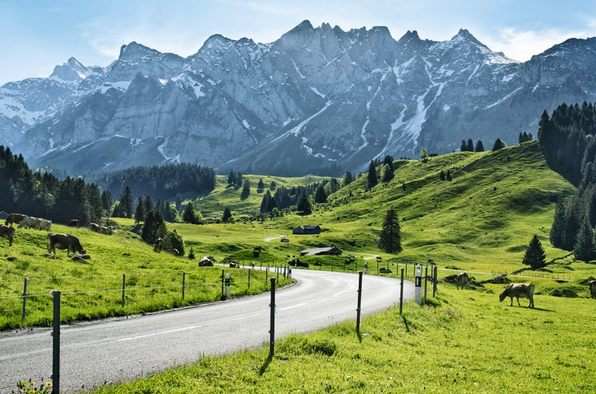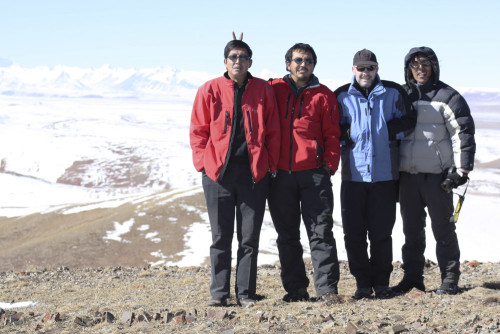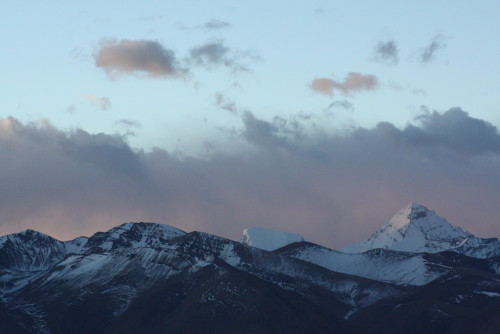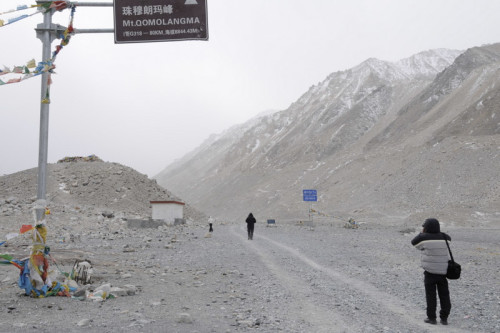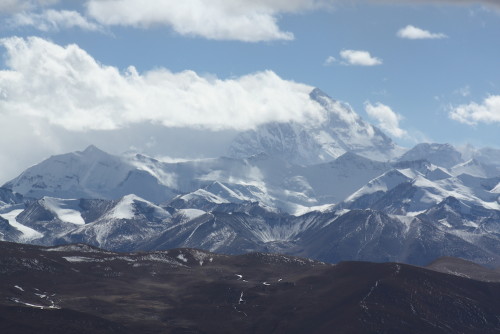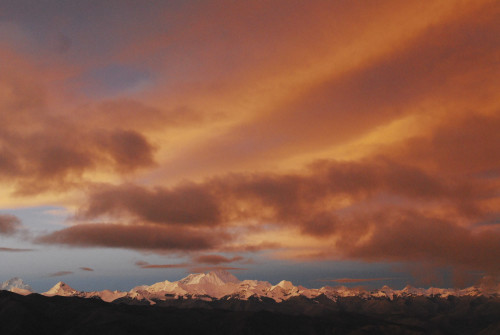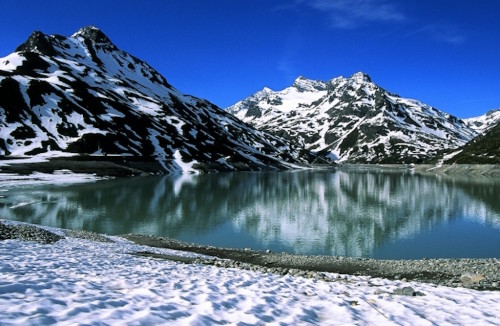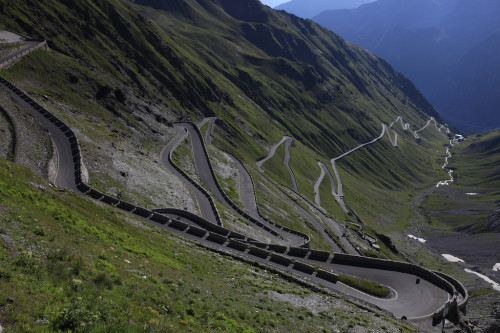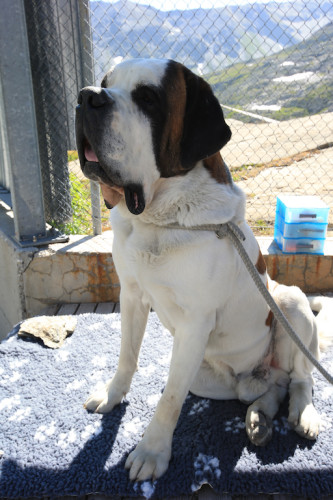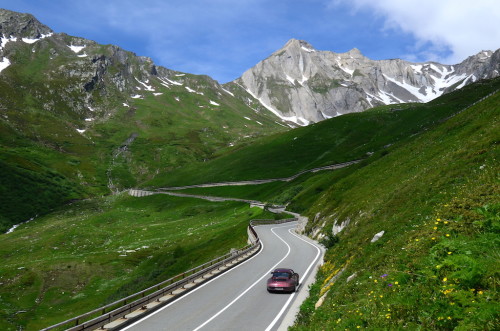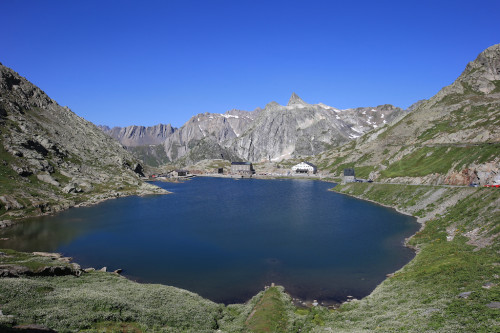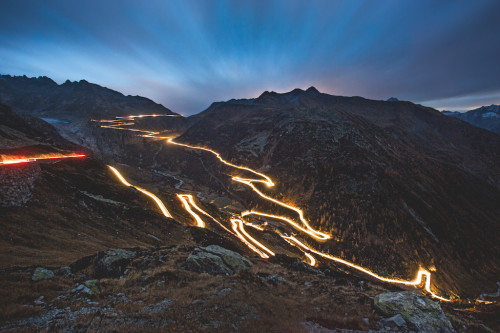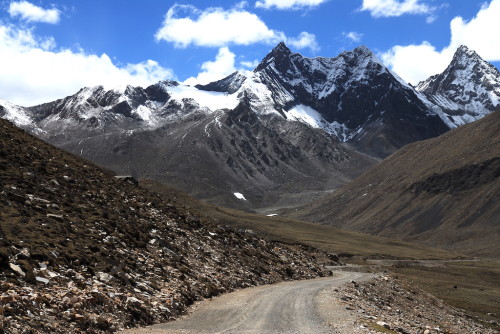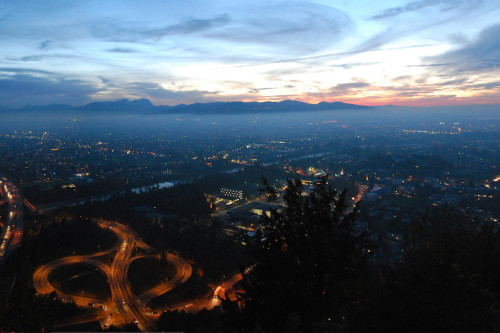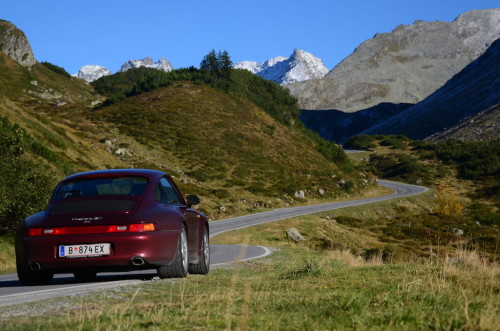Last month, we shared our favourite mountain passes in Tibet. This month, we’re looking to Europe, with its classic mountain drives in the Alps and beyond…
Tag Archives: Mountain Passes
Posted on 10 May, 2016
In November 2010, Peter and I spent a few weeks in Qinghai and Tibet researching new itineraries – routes that became Roads on the Roof of the World and the Qinghai version of Tibetan Highlands.
We had enjoyed an adventurous start to the trip, including an attempt (quickly abandoned) at winter camping in Tuotuohe, and what must have been one of the longer picnics in Qinghai’s history as we waited for an over-ambitious lamb stew to cook 5,000 metres above sea level. But, as we arrived in Lhasa, fatigued but at least thoroughly acclimatised, the trip’s highlight – Mount Everest – still lay ahead.
After a few days in Lhasa, we set out for the mountains. As we drove west of Shigatse, human settlements thinned out dramatically and the landscape grew steadily more otherworldly. Bands of ochre sediment jutted out at strange angles, hinting at the violence of the collision that forced the Tibetan Plateau three miles into the sky – and pushed the mountain peaks higher still. Eventually, we came to Baiba.
Baiba is a rugged little town that sits beside the highway to Nepal. Nobody would choose to stay here, except for the fact that it is conveniently close to the turn-off for Mount Everest’s North Base Camp. We stopped here one evening, four days out from Lhasa. After looking at hotels and restaurants and an hour spent sitting wrapped in blankets, talking and playing cards by candlelight, we called it a night.
The following morning our alarms rang well before dawn. Bundled up like onions in thick layers of clothing, we loaded the cars and set off. The beginning of the journey was stop-start as we passed through checkpoints and turned onto the gravel road (now paved) to Base Camp. As we climbed through a long series of switchbacks, suspense grew. We were climbing up to Pang-La, the first pass from which Everest is visible – would the peak be clear?
I was sitting in the first car in our two-car convoy. As we crested the pass, I used the walkie-talkie to report, incisively, that, “Oooh,it’s beautiful!” Dawn had painted the smaller peaks with a rosy glow, and there was a gorgeous arc of white-capped mountains before us. But the larger peaks were shrouded in thick cloud, as we used a signboard to work out where Everest, Lhotse, Makalu and Cho Oyu ought to be.
It is a long drive from Pang-La to Everest, and it seems even longer when you can’t see the mountain in question. We drove on in hope that the weather would clear, but the mountains stayed locked in behind the cloud as the morning wore on. Early that afternoon we arrived at a deserted Base Camp and scrambled up a huge and crumbly lump of moraine that is used as a viewpoint when there’s something to view. A wall of mist swirled before us, as we tried to imagine how huge the mountain would be at such close quarters.
Eventually, even Peter – usually the most optimistic person in such situations – conceded that we might as well turn back. So we turned around and began to drive back to Baiba, disappointed and empty-handed, for we had hoped to come away with some photos of Everest for our new journey dossiers. Seeing Everest was one of my top travel ambitions, and it seemed such a pity to have been to Base Camp without getting so much as a glimpse of the north face.
Late that afternoon, as we were climbing back up to Pang-La, my car’s walkie-talkie crackled into life. “I think the clouds are clearing,” came the message. And they were. One by one the mighty 8,000 metre peaks emerged, looming twice as high and more massive than we’d imagined. My disappointment evaporated and – just as suspense had mounted that morning – excitement began to mount as we zig-zagged back up to the pass.
Since that first trip I’ve had brilliant luck with the weather in these mountains. And while it’s an incredible experience each and every time – I always end up gazing at the highest peaks for minutes on end – nothing compares to the thrill of that first sighting. The clouds never completely cleared and we only had a short while before the weather closed in again, but it was enough to create an indelible memory of just how magnificent our world is. And that is the point of travel, is it not? Well, that and being able to say you’ve eaten lamb casserole at 5,000 metres above sea level…
Posted on 15 Mar, 2016
(For Part I, click here)
The only way I can describe driving among the mountains on that day is as a sensation of near-flight. Gliding along the perfect mountain roads, I seemed to soar and sink, descend and climb, and in these motions partake in the sensations unique to flight, at once accelerating forward, upward and sideways. On those mountain roads, I felt like a hawk, lifted and dropped at a thermal’s whim. The road set my course as the wind directs a paraglider’s flight. At times, I slowly ascended on a straight path, while at others, I spiraled up around serpentine twists and – coming to a standstill – seemed to float in midair atop each saddle. With each pass crested, I swooped into the first tight hairpin bend, only to take off once again as I reached the bottom of each valley. That morning, I frolicked and played for hours, diving into broad valleys and cleaving a way between sharp peaks, forgetting about the world left underneath.
In the past – as was the case on this particular day – I had to steal a moment here or there to get my fix of mountain roads. Nowadays, it’s part of my job: I can’t believe my luck! In designing our European driving holidays, one pass that often features high on the list of “must-drives” is the Stelvio (or Stilfserjoch) at the eastern end of the Swiss-Italian border. With its 48 hairpin turns, it attracts not only drivers of cars and motorbikers, but also masochistic cyclists. For one reason or another, it has become the iconic Alpine pass and I am asked about it time and again.
So, last year when a client asked “Can we drive The Italian Job?”, I was taken aback. I hadn’t thought about the movie or the mountain pass featured in the original 1969 version of the film for a long, long time. “Of course,” I replied, relishing the thought that, in preparation for this client groups’ trip, I would be forced, as it were, to drive it ahead of time to re-familiarize myself with it.
Rather than the dramatic Stelvio Pass, The Italian Job features the Grand St. Bernard Pass, which straddles the Swiss-Italian border far to the west. This is the mountain pass that gave the St. Bernard dog its name. (I grew up with one of these furry, cuddly beasts, and always struggled to measure up to its size, much as my mom struggled to rid my clothes of its sticky, long hairs.)
Eventually, the day arrived, last June, when I drove the Grand St. Bernard again, retracing the legendary Italian-side ascent featured so beautifully in the opening scene of The Italian Job. While Rossano Brazzi drives his Lamborghini Miura through turn after turn, along this Alpine road on a gorgeous day, the song On Days Like These plays in the background. Never in the history of movie-making has a song matched the emotion evoked by the opening sequence of a film so well.
In my case, it was a lovely spring day and I was on my way from Milan to Gstaad in Switzerland. These days, the main road through the Aosta Valley goes through an ugly tunnel from Italy into Switzerland. If you want to drive over the pass, as I did, you have to pay attention to find the right turn-off, otherwise you might zip right past it.
The Italian Job road is relatively short, but what it lacks in length it compensates for with scenic beauty and spectacularly twisting bends. Its curves are just as enjoyable to drive as those of the Stelvio, if not more so: some of the Stelvio tornante are downright hard work, and drivers that miscalculate are forced, embarrassingly, to make a three-point turn. The Grand St. Bernard’s corners are gentle and a breeze to drive. Nerd that I am, I started playing On Days Like These, cranked up the volume, rolled down the window and opened the sunroof for the climb to the pass. The meadows were covered with spring flowers – I stopped a few times to smell them and take photos – and at the top, as spring gave way to vestiges of winter, I saw patches of snow. After parking my car by the lake that graces the pass, I got out, leant against the bonnet, turned my head toward the sun and closed my eyes to listen to the birdsong that floated on the breeze.
Indeed, on days like these…
Please click this link an example of one of our On the Road in Europe itineraries that features the Grand St. Bernard Pass.
Posted on 5 Mar, 2016
For most people and much of human history, mountain passes evoked visions or memories of anything but pleasure. Instead, they were associated with the pinnacle of hardship as traders, exhausted and starving, struggled to carry their wares across mountain ranges wrapped in deep snow and whipped by ferocious winds. Or they were frozen graveyards of soldiers since mountain ranges formed natural boundaries turned political borders. Mountain passes were the places where one came face-to-face with the enemy and the violence of war.
How different my world is. I grew up in the heart of the Alps and in a period of peace and unprecedented wealth creation: there are fabulous roads to drive across the Alps and the only enemy I recall encountering at the top of a mountain pass was a bird that shat into my open-top car while I got myself a grilled sausage from a stand by the roadside.
According to one website for motorbikers, there are over 300 mountain passes dotting the Alps. I must have driven across at least a third of them, including some of the highest, like the Col de la Bonette in eastern France.
(When I drove across this one many years ago I felt quite proud, though I’ve since driven over a mountain pass on the S304 in Tibet that’s early twice as high, topping out at 5,450m.)
Once, on one day alone, I crossed fifteen Alpine passes. On days like these, when I have the luxury of driving for fun, the agony of waking to the sound of an alarm clock in the early hours of the morning was almost instantaneously replaced with eager anticipation of the treat to come. In no time, I was up, dressed, had put on my soft driving shoes (all the better to work the pedals), and had rushed out to my car.
On that morning I started off in Bregenz, an Austrian town by Lake Constance. At first, with the early morning temperature hovering around five degrees Celsius, the car’s engine was still cold, not ready to be put through its paces. The engine spluttered and vibrated edgily in its compartment. But by the time I reached the city boundaries, heading south, it was purring and I was raring to go.
When the last of the city’s stop-lights turned green, it threw open the road before me. I sped up and found myself rushing toward immense beauty: the black, purple, pink and orange of dawn in the Rhine valley. There was the instant thrill of being pressed into my seat, feeling the engine coming, then coming again, and again, as I shifted through the gears. It was a sensation of total immersion and bursting free, both at the same time.
About an hour later, the sun rose and divided the world in two, the still-dark valleys below and the glorious mountains above. In fact, I had finished climbing the first mountain, the Bielerhöhe, which separates Austria’s two western-most states, and was already descending into a Tyrolean valley, negotiating hairpin turns on the way down, one after another.
The only way I can describe driving among those mountains on that day is as a sensation of near-flight…
Come back for the continuation of On days like these … soon…
